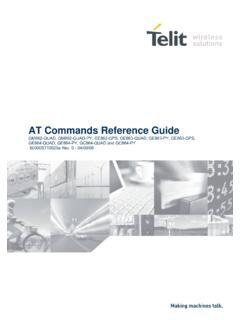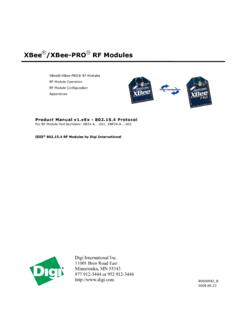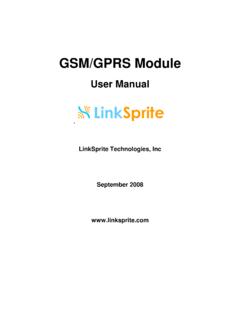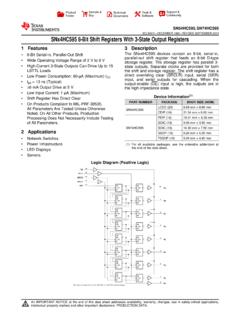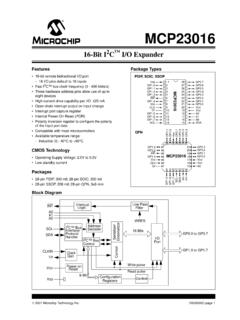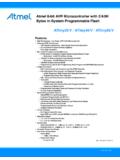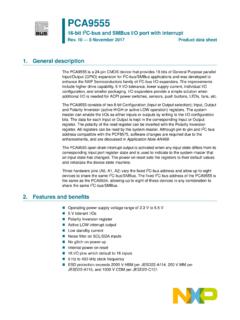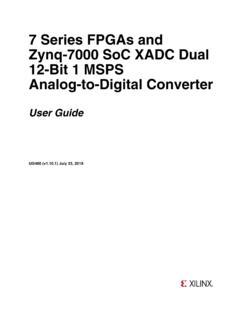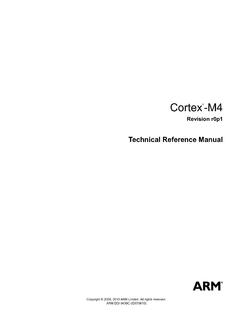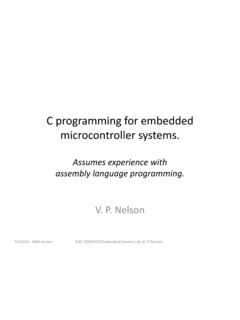Transcription of DS1307 64 x 8 Serial Real-Time Clock - SparkFun Electronics
1 1 of 12100101 FEATURES Real-Time Clock (RTC) counts seconds,minutes, hours, date of the month, month, dayof the week, and year with leap-yearcompensation valid up to 2100 56-byte, battery-backed, nonvolatile (NV)RAM for data storage Two-wire Serial interface Programmable squarewave output signal Automatic power-fail detect and switchcircuitry Consumes less than 500nA in battery backupmode with oscillator running Optional industrial temperature range:-40 C to +85 C Available in 8-pin DIP or SOIC Underwriters Laboratory (UL) recognizedORDERING INFORMATIONDS1307 8-Pin DIP (300-mil)DS1307Z 8-Pin SOIC (150-mil)DS1307N 8-Pin DIP (Industrial)DS1307ZN 8-Pin SOIC (Industrial)PIN ASSIGNMENTPIN DESCRIPTIONVCC - Primary Power SupplyX1, X2 - Crystal ConnectionVBAT - +3V Battery InputGND - GroundSDA - Serial DataSCL - Serial ClockSQW/OUT - Square Wave/Output DriverDESCRIPTIONThe DS1307 Serial Real-Time Clock is a low-power, full binary-coded decimal (BCD)
2 Clock /calendarplus 56 bytes of NV SRAM. Address and data are transferred serially via a 2-wire, bi-directional Clock /calendar provides seconds, minutes, hours, day, date, month, and year information. The end ofthe month date is automatically adjusted for months with fewer than 31 days, including corrections forleap year. The Clock operates in either the 24-hour or 12-hour format with AM/PM indicator. TheDS1307 has a built-in power sense circuit that detects power failures and automatically switches to thebattery x 8 Serial Real-Time 8-Pin SOIC (150-mil) DS1307 8-Pin DIP (300-mil)X1X2 VBATGNDVCCSQW/OUTSCLl2348765 SDAl2348765X1X2 VBATGNDVCCSQW/OUTSCLSDADS13072 of 12 OPERATIONThe DS1307 operates as a slave device on the Serial bus.
3 Access is obtained by implementing a START condition and providing a device identification code followed by a register address. Subsequent registerscan be accessed sequentially until a STOP condition is executed. When VCC falls below x VBAT thedevice terminates an access in progress and resets the device address counter. Inputs to the device willnot be recognized at this time to prevent erroneous data from being written to the device from an out oftolerance system. When VCC falls below VBAT the device switches into a low-current battery backupmode. Upon power-up, the device switches from battery to VCC when VCC is greater than VBAT + recognizes inputs when VCC is greater than x VBAT.
4 The block diagram in Figure 1 shows themain elements of the Serial BLOCK DIAGRAM Figure 1 TYPICAL OPERATING CIRCUITDS13073 of 12 SIGNAL DESCRIPTIONSVCC, GND DC power is provided to the device on these pins. VCC is the +5V input. When 5V isapplied within normal limits, the device is fully accessible and data can be written and read. When a 3 Vbattery is connected to the device and VCC is below x VBAT, reads and writes are inhibited. However,the timekeeping function continues unaffected by the lower input voltage. As VCC falls below VBAT theRAM and timekeeper are switched over to the external power supply (nominal DC) at Battery input for any standard 3V lithium cell or other energy source.
5 Battery voltage must beheld between and for proper operation. The nominal write protect trip point voltage at whichaccess to the RTC and user RAM is denied is set by the internal circuitry as x VBAT nominal. Alithium battery with 48mAhr or greater will back up the DS1307 for more than 10 years in the absence ofpower at 25 C. UL recognized to ensure against reverse charging current when used in conjunction with alithium Conditions of Acceptability at ( Serial Clock Input) SCL is used to synchronize data movement on the Serial ( Serial Data Input/Output) SDA is the input/output pin for the 2-wire Serial interface.
6 The SDApin is open drain which requires an external pullup (Square Wave/Output Driver) When enabled, the SQWE bit set to 1, the SQW/OUT pinoutputs one of four square wave frequencies (1Hz, 4kHz, 8kHz, 32kHz). The SQW/OUT pin is opendrain and requires an external pull-up resistor. SQW/OUT will operate with either Vcc or Vbat , X2 Connections for a standard quartz crystal. The internal oscillator circuitry isdesigned for operation with a crystal having a specified load capacitance (CL) of more information on crystal selection and crystal layout considerations, please consult ApplicationNote 58, Crystal Considerations with Dallas Real-Time Clocks.
7 The DS1307 can also be driven by anexternal oscillator. In this configuration, the X1 pin is connected to the external oscillatorsignal and the X2 pin is LAYOUT FOR CRYSTALDS13074 of 12 Clock ACCURACYThe accuracy of the Clock is dependent upon the accuracy of the crystal and the accuracy of the matchbetween the capacitive load of the oscillator circuit and the capacitive load for which the crystal wastrimmed. Additional error will be added by crystal frequency drift caused by temperature shifts. Externalcircuit noise coupled into the oscillator circuit may result in the Clock running fast.
8 See Application Note58, Crystal Considerations with Dallas Real-Time Clocks for detailed review Application Note 95, Interfacing the DS1307 with a 8051-Compatible Microcontroller for additional AND RAM ADDRESS MAPThe address map for the RTC and RAM registers of the DS1307 is shown in Figure 2. The RTC registersare located in address locations 00h to 07h. The RAM registers are located in address locations 08h to3Fh. During a multi-byte access, when the address pointer reaches 3Fh, the end of RAM space, it wrapsaround to location 00h, the beginning of the Clock ADDRESS MAP Figure 2 Clock AND CALENDARThe time and calendar information is obtained by reading the appropriate register bytes.
9 The RTCregisters are illustrated in Figure 3. The time and calendar are set or initialized by writing the appropriateregister bytes. The contents of the time and calendar registers are in the BCD format. Bit 7 of register 0is the Clock halt (CH) bit. When this bit is set to a 1, the oscillator is disabled. When cleared to a 0, theoscillator is note that the initial power-on state of all registers is not defined. Therefore, it is importantto enable the oscillator (CH bit = 0) during initial DS1307 can be run in either 12-hour or 24-hour mode. Bit 6 of the hours register is defined as the12- or 24-hour mode select bit.
10 When high, the 12-hour mode is selected. In the 12-hour mode, bit 5 isthe AM/PM bit with logic high being PM. In the 24-hour mode, bit 5 is the second 10 hour bit (20-23 hours).On a 2-wire START, the current time is transferred to a second set of registers . The time information isread from these secondary registers , while the Clock may continue to run. This eliminates the need to re-read the registers in case of an update of the main registers during a x 800H07H08H3 FHDS13075 of 12DS1307 TIMEKEEPER registers Figure 3 CONTROL REGISTERThe DS1307 control register is used to control the operation of the SQW/OUT 7 BIT 6 BIT 5 BIT 4 BIT 3 BIT 2 BIT 1 BIT 0 OUT00 SQWE00RS1RS0 OUT (Output control): This bit controls the output level of the SQW/OUT pin when the square waveoutput is disabled.
